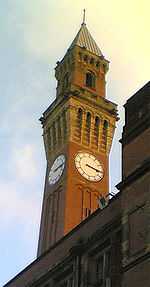10515 Old Joe
| Discovery | |
|---|---|
| Discovered by | Brian G. W. Manning |
| Discovery date | October 31, 1989 |
| Designations | |
Named after | Joseph Chamberlain Memorial Clock Tower |
|
1952 YD; 1989 UB3; 1993 TB3 | |
| Main belt | |
| Orbital characteristics | |
| Epoch November 26, 2005 (JD 2453700.5) | |
| Aphelion | 484.303 Gm (3.237 AU) |
| Perihelion | 284.819 Gm (1.904 AU) |
| 384.561 Gm (2.571 AU) | |
| Eccentricity | 0.259 |
| 1505.422 d (4.12 a) | |
Average orbital speed | 18.26 km/s |
| 302.205° | |
| Inclination | 5.424° |
| 61.414° | |
| 19.595° | |
| Physical characteristics | |
| Dimensions | ? km |
| Mass | ?×10? kg |
Mean density | 2.0? g/cm³ |
| ? m/s² | |
| ? km/s | |
| ? d | |
| Albedo | 0.05? |
| Temperature | ~176 K |
Spectral type | ? |
| 14.1 | |
|
| |
10515 Old Joe is a main-belt asteroid discovered by Brian G. W. Manning on October 31, 1989 from Stakenbridge, in the village of Churchill, near Kidderminster, Worcestershire, England. It is named after the Joseph Chamberlain Memorial Clock Tower (nicknamed Old Joe) at the University of Birmingham.[1]

"Old Joe", the University Clock Tower, which the asteroid was named after.
References
- ↑ "10515 Old Joe (1989 UB3)". JPL Small-Body Database. Retrieved 2008-02-17.
| ||||||
| ||||||||||||||||||||||||||||